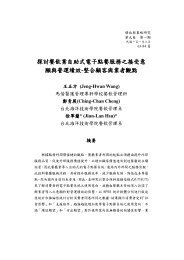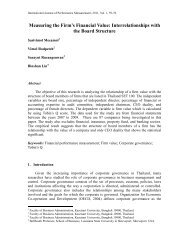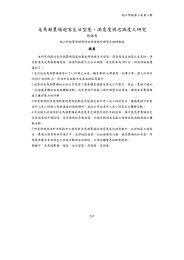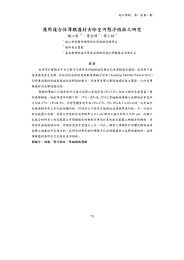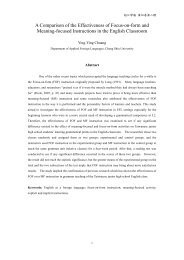ç®é - ç 究ç¼å±è - 稻æ±ç§ææ¨ç®¡çå¸é¢
ç®é - ç 究ç¼å±è - 稻æ±ç§ææ¨ç®¡çå¸é¢
ç®é - ç 究ç¼å±è - 稻æ±ç§ææ¨ç®¡çå¸é¢
You also want an ePaper? Increase the reach of your titles
YUMPU automatically turns print PDFs into web optimized ePapers that Google loves.
稻 江 學 報 第 五 卷 第 一 期<br />
Web 2.0 technology. The most common Web 2.0 tools relate to social-networking, such as Blogs, Facebook, Wiki,<br />
and Second Life. The main concept behind social-networking is allowing people to connect, easily and deeply, with<br />
others and also to create positive learning from the interaction. The concepts of interaction and participation are<br />
frequent topics when people discuss new social networking technologies (Diehl, 2007). Web 2.0 tools have the<br />
potential to provide significant amounts of conversation for course interactions among learners, and among<br />
instructors and learners.<br />
Literature review<br />
Second Life<br />
Second Life (SL), compatible with Windows, MAC OS X, and Linux operating systems, successfully attracts<br />
many users. Second Life is a 3-D version of the Web and enables users’ teaching and social activities: Instructors can<br />
create and design a virtual class for a course. The Second Life program provides a novel atmosphere for playing an<br />
on-line game or access wide-open spaces to extend creativity. Many universities and colleges have virtual space,<br />
called “land” to establish campuses in SL, where classes meet and students interact in real time. For instance, Lagorio<br />
(2007) provided an interface (Figure 1.) to show that participants can hold chat discussions and create multimedia<br />
presentations from virtual building blocks.<br />
Figure 1. A Harvard Law School lecture in Second Life (Lagorio, 2007).<br />
In preparing for instructors to develop a learning program for older adults in Second Life, the important thing<br />
for instructors is to design a blueprint for older learners before applying the technology to the course. In the virtual<br />
environment, orientation is necessary for elder students to understand how to use the program and ensure they can<br />
enjoy the learning process.<br />
Also, designers can ask some veterans of the course to volunteer for this assistant’s job, so elder learners not<br />
only gain new knowledge during the course, but also develop self-confidence when they help other learners to solve<br />
problems. The help station is an important factor for a fruitful course because it facilitates the learning process for<br />
elder learners to navigate the virtual space.<br />
Wiki<br />
Another effective technology related to Web 2.0 is Wiki which is a group of web pages that allows users to<br />
access the web-pages and to modify contents. An advantage of Wiki over other e-learning technologies, such as<br />
Angel or Blackboard, is that users can collaboratively edit contents. Wiki benefits older adults because it offers an<br />
uncomplicated interface for elder learners, and it is particularly effective for contributing and exchanging information<br />
through teamwork. Schaffert (2006) provided a graphic which allows experiencing a sample of an interface page in<br />
Wiki (Figure 2.).<br />
280



